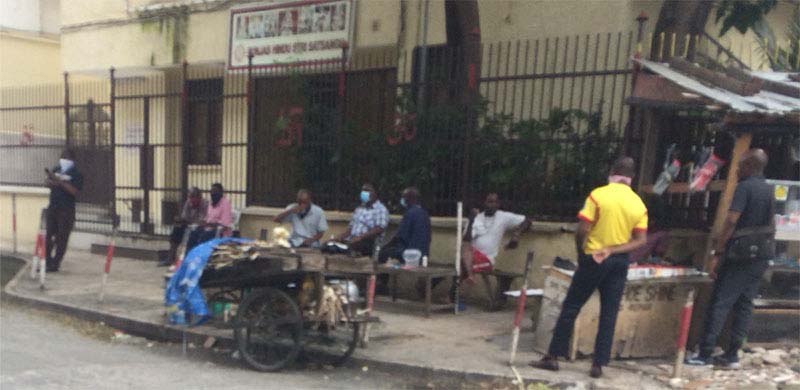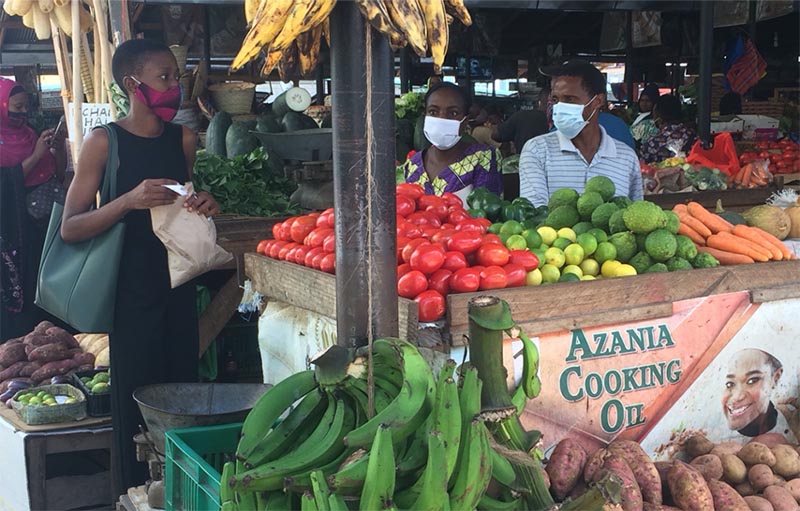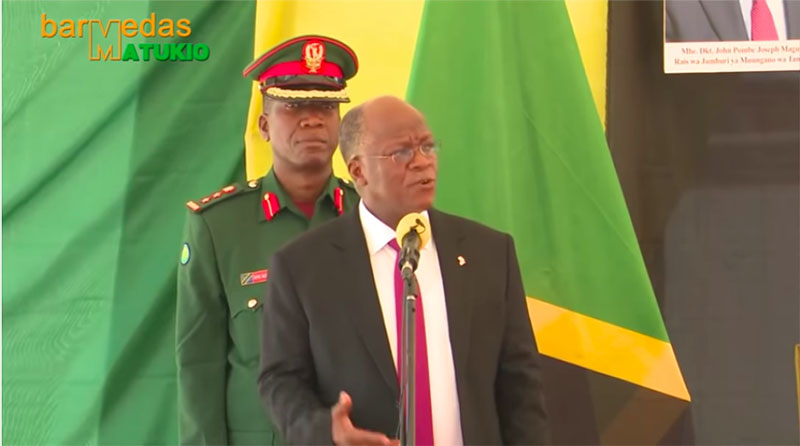Editor’s note: This post is the fourth in our five-part series “COVID-19: Views from the Field.” Click here to read an introduction written by series organizer Rebekah Ciribassi.
I have been living in Tanzania since March of 2018, conducting ethnographic fieldwork with Tanzanian families that have a genetically-inherited blood disorder called sickle cell disease. My interest in studying the socio-political life of this particular diagnosis in this particular place started in 2012, when I learned of a Pan-African bioscience movement, sited partly in Tanzania, to prioritize sickle cell disease research and care across the continent. I became curious about what it might mean anthropologically to shift the timescales of global health intervention from the immediacy of more traditionally-prioritized communicable diseases like HIV and malaria, toward the intergenerational transmission of a genetic condition. Almost two years of interviews and observation with families, activists, and healthcare providers had me thinking about the constitution of longue durée bodily time through genetic technologies. And then the pandemic started.
By the time the first official case of COVID-19 was announced in Tanzania on March 16th, I had already stopped in-person interviews and travel for research. Although no one was quite sure the extent of the spread, I was wary of becoming a vector for the virus among my friends and interlocutors, many of whom are either immunocompromised from sickle cell disease or are much-needed healthcare workers in local hospitals. But even beyond the biological risk, there was something else keeping me from fieldwork: the pandemic had snapped the relevant temporalities of care back to that immediacy of a fast-spreading communicable disease, and the slower pace of both ethnography and chronicity began to feel incongruent.
Now, six weeks later, the virus has begun its exponential growth phase in Tanzania, with 480 cases announced at the time of writing. All flights out of the country have been cancelled, and while there are no official lockdown orders or policies to restrict movement in Tanzania, much of “normal” life has come to a halt. As an ethnographic researcher, I find myself in the strange liminal space of being physically stagnant and isolated in “the field” without being able to actively do fieldwork. Temporalities collide; the slow-burn of ethnographic sensibilities, the time-to-degree clock at my university, the evolutionary time of genomics, the multi-year arc of doctoral study are all incommensurable with the rapidity of the new pandemic timescape. At this moment of disjuncture, it becomes useful to ask about the politics of these temporalities, especially as they are emplaced in this loosely defined place I call the field.
Colonial Legacies and the Historicity of Contagion
In one of his recent essays, Tanzanian scholar Chambi Chachage points toward a discrepancy between some of the journalistic takes on Coronavirus in Europe versus in Africa. In Europe, narratives abound about the responses to pandemics past. The Black Death spreading to Italy in 1437, the Spanish Flu in Europe and North America in 1918—there is a centuries-long time depth from which journalists have drawn predictions about the future of COVID-19 in the West. But although a “pandemic” is global by definition, the spread of these same catastrophic contagions across Africa is rarely part of this imaginary of pandemic history. This is not for a lack of documentation; some historians have written on influenza pandemics in sub-Saharan Africa [1] [2]. So it isn’t exactly a dearth of knowledge that keeps us from talking much about pandemics-past here. It’s rather a question of the way in which that knowledge circulates as long-term collective memory.
This is not a purely academic concern. It matters for how people in Tanzania, and Africa more generally, experience COVID-19. Before Coronavirus really took hold anywhere in Africa, in Dar es Salaam there was a general feeling that it couldn’t happen here. On my social media feeds and in casual conversations, people seemed to be telling each other: there are African diseases and there are European diseases, black diseases and white diseases. Malaria is “African.” HIV/AIDS is “African.” But this new virus looked like something different: a white, European disease. For a few weeks in March, instead of getting called mzungu—white foreigner—by strangers in some public markets, I got called jokingly called “Corona.” Racialized logics sprouted for why COVID-19 wouldn’t cross the color line. There was even a theory floating around the internet (both in the U.S. and in Tanzania) that black skin was literally protective against transmission. Theories about tropical climates as protective against the virus began circulating (echoing older, environmental determinist logics of European imperialism). There seemed to be an unthinkability of a pandemic that would start in China and Europe and then later move toward Africa, even though this is exactly what had already happened several times centuries before. So why the apparent unthinkability?
Africanist historians have chronicled how colonial biomedicine created the concept of “the African body” in the service of empire. Africa was built into the European imagination as the personification of disease, suffering, disorder, and contagion: the “dark continent” in need of the hygienic sanitization from the white doctor [3][4]. The lasting impact has been the durable racialization of African bodies as the categorically distinct and biologically pathological “Other.” Now, during COVID-19, this very same racist fear of contagion has led to African migrants being evicted from their homes in China. As colonial biomedicine discursively constructed the African Body as the archetypal source of infection threatening the “healthy,” white body politic, the flow of contagion was imagined to be unidirectional: from Africa outwards, and never visa-versa. And further, the colonial construction of Africa as the continent “without history,” as the primordial birthplace of humanity and excluded from modernity, gave the African body a particular temporality that lacked historicity. This is, of course, not to say that colonial medicine was monolithic across Africa, that it went unchallenged, or that it has determined the course of medicine on the continent ever since. But it is worth pulling apart the colonial legacies that haunt the discursive and material emergence of the COVID-19 pandemic in Africa—legacies that have carried a particular politics of time.

Streetside socializing in downtown Dar es Salaam on May 1, 2020. Photo credit Sophia George Mrema.
Urgency, Futurity, and Nation-Building
Tanzania’s leader, President Magufuli, has received criticism for how he has handled COVID-19 so far. At the beginning, there was a slow and gradual initial response as the cases started trickling in. He first urged Tanzanians to wash their hands and avoid large gatherings, then started quarantining foreigners who came into the country, and closed all schools. But to date, borders are technically open, places of worship, markets, and public transportation are still active, and there are no mandatory lockdown or curfew orders like the ones in nearby nations. The President has, on multiple occasions, insisted that Tanzanians keep going out to “work hard” for the good of the national economy. He has cautioned against uncritically copying the strategies of foreign countries, and has expressed suspicion about the supplies brought in as aid from other countries. Just this week his government accused government laboratory workers of being “bought out by imperialists” for giving supposedly faulty COVID-19 test results. Instead of trusting foreign help, he suggested Tanzanians rely on traditional herbal steam therapy (kujifukiza). It appears, therefore, that Magufuli understands this crisis as a threat to Tanzania’s sovereignty, and a chance to assert Tanzanian self-determination. In his effort to spare the economy and bolster a sense of national pride, Magufuli has built a response that looks back at a “traditional” past and toward the long-term future of Tanzania. In the meantime, cases are increasing at an exponential rate that surpasses neighboring countries, and critics argue that the response lacks the short-term urgency necessary to curb the spread.
Most evaluations of African responses to the pandemic have glossed it as a debate either for or against lockdowns. In this frame, it is a choice between economic precarity or medical precarity. But I suspect this might be more thoroughly understood as a clash of temporalities. The call for urgency, whether that comes in the form of lockdowns, curfews, or other measures, is fundamentally a shift to focus on the short-term immediacy of a health crisis. It is a call for swift action, with little chance of predicting the coming weeks or months. The disempowerment of public social services across Africa, beginning with colonialism and dramatically accentuated under Structural Adjustment Programs in the 1980s, has gutted a health system and led to health interventions that have already been unstable and necessarily short term. The logistical challenges of caring for COVID-19 patients in Tanzania are a reflection of a longer history of a system operating under constant triage [5]. Under these conditions, the provision of healthcare has been dependent on international aid projects and pharmaceutical research. Against this backdrop, a French doctor made the case in early April, 2020 that Coronavirus vaccines should be tested on Africans. His comments sparked outrage among Africans across the continent. The controversy brought to the fore the extent to which medical urgency and the need to provide care in an overburdened health system can invite neocolonialism, racism, and risk. A pandemic demands fast action with short-term results, but in Africa these fast actions have historically come with consequences for sovereignty.
Both sovereignty and nationalism are ideologies that depend on particular narratives of both past and future, whereas a global pandemic creates a temporal cut: histories and futurities are luxuries that the constant precarity of the present just won’t allow.
The Temporal Politics of Making Contact
“There is no knowledge of the Other which is not also a temporal, historical, a political act” (Fabian (1983:1). [6]
Perhaps the most unsettling thing about the COVID-19 pandemic is that temporal cut. Both collective memory and imagined futurity become radical acts in the face of contagion. The immediacy of a pandemic narrows the scope of attention to just the moment of contact—with necessarily political effects.
Meanwhile, ethnographic contact has also become a threat. But in the past few months, we as social scientists, anthropologists, and culture theorists have been asked to make conclusions in real time, and from a distance, about the socio-political dynamics of the COVID-19 pandemic. Whereas the usual practice of ethnography is a slow, long-term engagement with a question, spending years on end before publishing, pandemic life has compressed ethnographic time and enrolled us in the global virus response effort. Ethnographers are suddenly simultaneously stagnant and also coping with a new, accelerated mode of engaging with and communicating fieldwork. This is significant not only for the quality of the conclusions that we might reach, but also because ethnographic fieldwork is always a political practice of performing and constituting time. [7]
In the face of these new challenges to ethnography, it becomes important to resist a pandemic imaginary of contact as either atemporal or apolitical. Ethnographers should be wary of a totalizing urgency, and understand moments of contact as irresolutely entangling multiple actors with their own ingrained temporalities—temporalities that have political stakes. Therefore, whether it is ethnographic contact (in person or technologically-mediated), contagious contact, or the kind of contact that leaves a genetically heritable trace (as in sickle cell disease), these moments are both indexical and productive of particular, nonlinear, political histories and futures.

Photograph of a food market with shoppers wearing face masks.
References
[1] Chouin, Gérard (2018). “Reflections on Plague in African History (14th–19th c.).” Afriques, no. 09. https://doi.org/10.4000/afriques.2228
[2] Killingray, David (2003). A New “Imperial Disease”: The Influenza Pandemic of 1918-9 and its Impact on the British Empire. Caribbean Quarterly 49(4):30-49.
[3] Vaughn, Megan (1991). Curing Their Ills: Colonial Power and Africa Illness. Stanford: Stanford University Press.
[4] Comaroff, Jean (1993). The Diseased Heart of Africa: Medicine, Colonialism, and the Black Body. In Knowledge, Power, and Practice: The Anthropology of Medicine and Everyday Life. Eds. Shirley Lindenbaum (Editor), Margaret M. Lock. University of California Press. Pp. 305-329.
[5] Nguyen, Vinh-Kim (2010). The Republic of Therapy: Triage and Sovereignty in West Africa’s Time of AIDS. Durham: Duke University Press.
[6] Fabian, Johannes (1983). Time and the Other: How Anthropology Makes Its Object. New York: Columbia University Press.
[7] Paul Wenzel, Geissler (2017). “Ethnography as Re-enactment : Performing Temporality in an East African Place of Science.” In How Do Biomedicines Shape People’s Lives, Socialities and Landscapes?, 143rd ed., 187–210. Senri Ethnological Reports. https://doi.org/10.15021/00008649.


2 Trackbacks